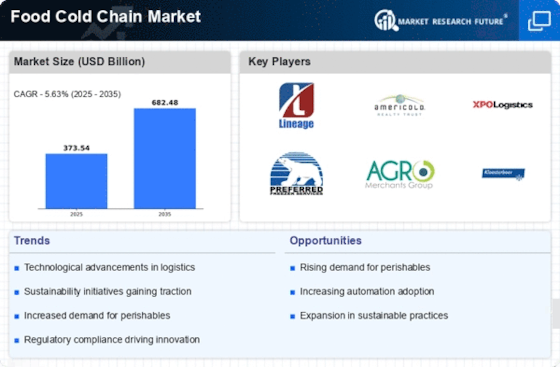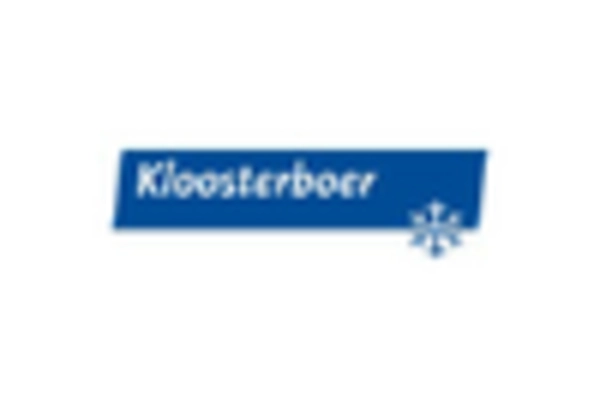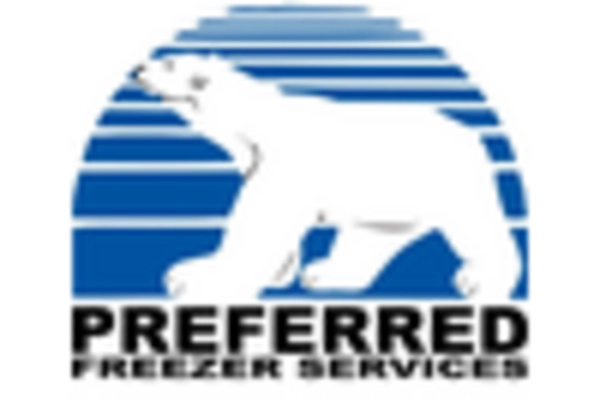Rising Demand for Perishable Goods
The increasing consumer preference for fresh and perishable food items is a primary driver of the Food Cold Chain Market. As consumers become more health-conscious, the demand for fresh produce, dairy products, and meat has surged. This trend is reflected in market data, which indicates that the perishable food segment is expected to grow at a compound annual growth rate of approximately 5.5% over the next few years. Retailers and suppliers are thus compelled to enhance their cold chain logistics to ensure product quality and safety. The Food Cold Chain Market plays a crucial role in maintaining the integrity of these products throughout the supply chain, from farm to table, thereby meeting consumer expectations and regulatory standards.
Consumer Awareness and Preference for Quality
There is a growing consumer awareness regarding food quality and safety, which is driving the Food Cold Chain Market. As consumers become more informed about the impact of food storage and transportation on product quality, they are increasingly demanding transparency from suppliers. This shift in consumer behavior is prompting businesses to invest in advanced cold chain solutions to ensure that their products meet quality expectations. Market Research Future indicates that approximately 70% of consumers are willing to pay a premium for products that guarantee freshness and safety. This trend underscores the critical role of the Food Cold Chain Market in delivering high-quality food products that align with consumer preferences.
Expansion of Retail and Distribution Channels
The expansion of retail and distribution channels is a vital factor influencing the Food Cold Chain Market. With the rise of supermarkets, hypermarkets, and online grocery platforms, the need for efficient cold chain logistics has intensified. Retailers are increasingly focused on optimizing their supply chains to ensure that perishable goods reach consumers in optimal condition. This trend is supported by market data showing that the retail sector for perishable goods is expected to grow by 6% annually. Consequently, the Food Cold Chain Market must adapt to these evolving distribution models, ensuring that cold chain solutions are scalable and capable of meeting the demands of diverse retail environments.
Regulatory Compliance and Food Safety Standards
The stringent regulatory environment surrounding food safety is a significant driver for the Food Cold Chain Market. Governments and health organizations worldwide have established rigorous standards to ensure the safety of food products, particularly perishables. Compliance with these regulations necessitates robust cold chain systems to maintain appropriate temperatures and prevent contamination. As a result, companies are increasingly investing in cold chain infrastructure to adhere to these standards. Market data indicates that the food safety compliance sector is projected to grow by 4% annually, further emphasizing the importance of the Food Cold Chain Market in safeguarding public health and maintaining consumer trust.
Technological Advancements in Cold Chain Solutions
Technological innovations are transforming the Food Cold Chain Market, enhancing efficiency and reliability. The integration of IoT devices, temperature monitoring systems, and automated logistics solutions has improved the tracking and management of perishable goods. For instance, the implementation of real-time temperature monitoring can reduce spoilage rates significantly, which is a critical concern for food distributors. Market analysis suggests that the adoption of advanced technologies could lead to a reduction in operational costs by up to 20%. As these technologies become more accessible, they are likely to drive further investment in the Food Cold Chain Market, ensuring that businesses can meet the growing demands of consumers and regulatory bodies.


















Leave a Comment